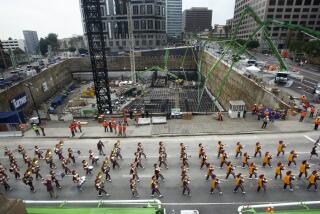Cement, Concrete Are as Different as Powder, Rock
- Share via
Often confused in speech even by industry insiders, cement and concrete are not the same thing.
Cement is a fine powder made by baking ground-up limestone ore and certain additives in a kiln at 2,700 degrees, allowing the mixture to cool and then stirring in gypsum, a white or yellowish-white mineral so soft it can be scratched with a fingernail.
Concrete is a quick-setting goo produced by combining cement with water, sand and gravel and mixing thoroughly, usually in a truck on the way to the construction site.
A cubic yard of concrete consists of about 1 1/2 tons sand and gravel, five to eight gallons of water and five to 7 1/2 sacks of cement weighing 94 pounds each.
So-called cement mixers could more accurately be termed concrete mixers, said Thomas P. Anderson, a geologist for the California Department of Conservation’s Division of Mines and Geology. If a truck gets a flat tire, the driver sometimes will pull a bag of sugar out of his cab and throw it in the mixer, he said. The sugar slows or prevents the concrete from setting.
“If it ever solidifies, he’s in with a jackhammer, cleaning out his truck,” Anderson said.
Sand, gravel and dust are put to different uses depending on the size of particle. Very fine sand and dust becomes asphalt. Coarse sand and gravel with a diameter of between and 1 1/2 inches is used in concrete.
Rocks more than 1 1/2 inches in diameter are pulverized and used as crushed stone. There are also hillside quarries that mine nothing but stone. Southern California’s construction industry is using more and more crushed stone as sand and gravel grow scarce, although the trend has yet to show up in statewide statistics. But crushed stone often is an expensive and less adequate substitute, except in asphalt.
Using a high proportion of crushed stone to make concrete results in a coarser product that is more difficult to pour and cannot easily be given a smooth finish. So-called manufactured sand has only become common in the last 10 years and has replaced about 10% to 15% of the natural sand used in the making of Southern California’s concrete, said Michael J. Kerstetter, CalMat’s executive vice president and general manager for concrete and aggregates.
Unlike sand and gravel, crushed stone can be harvested from steep hillsides unsuitable for crops and houses. As land zoned for sand and gravel mining grows more scarce, that may prove more important than the quality of the concrete.
More to Read
Sign up for Essential California
The most important California stories and recommendations in your inbox every morning.
You may occasionally receive promotional content from the Los Angeles Times.








